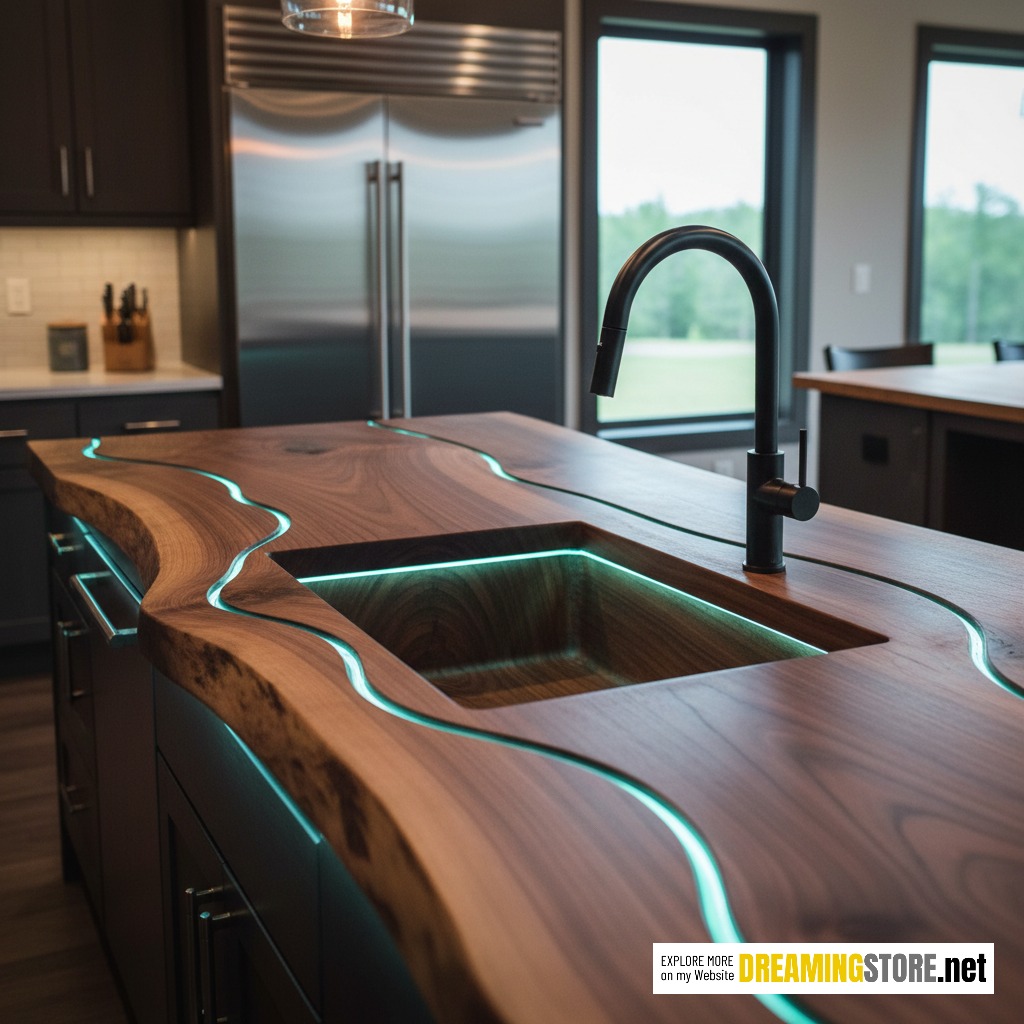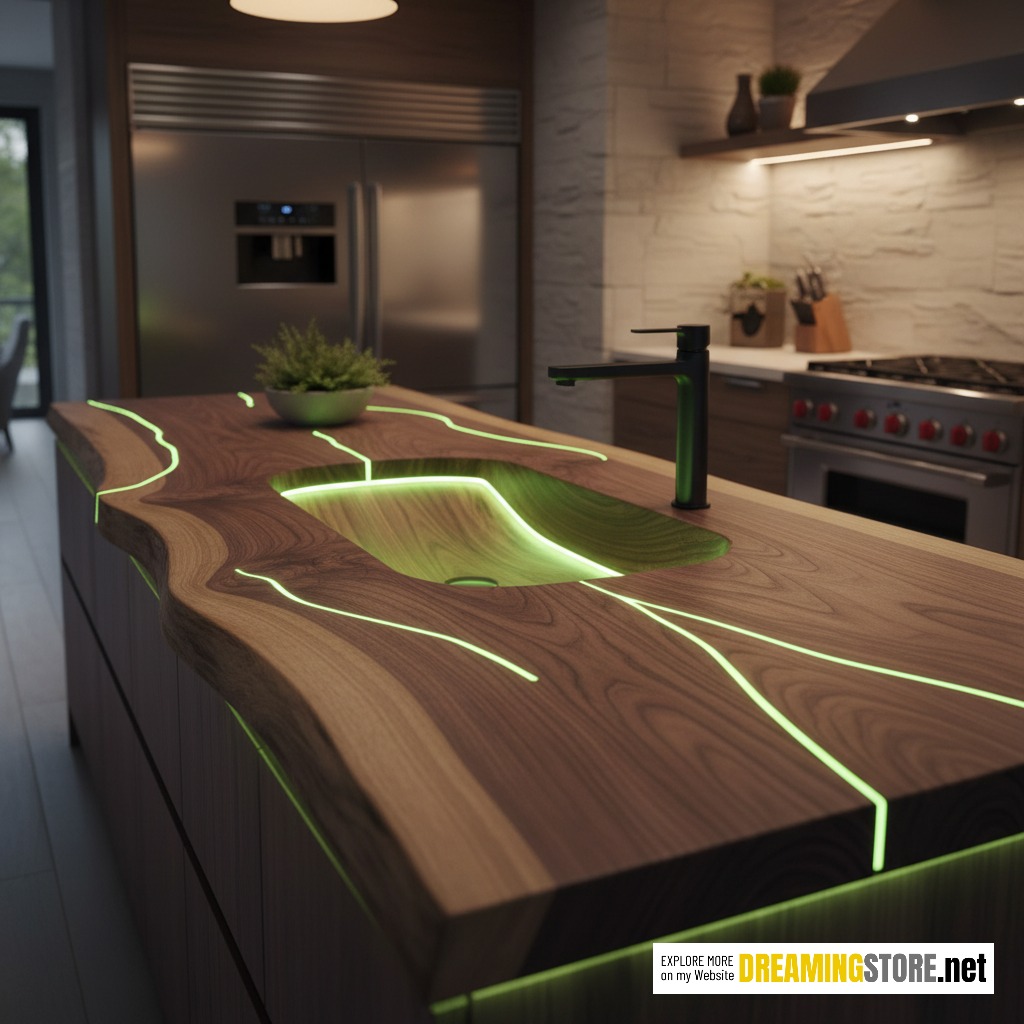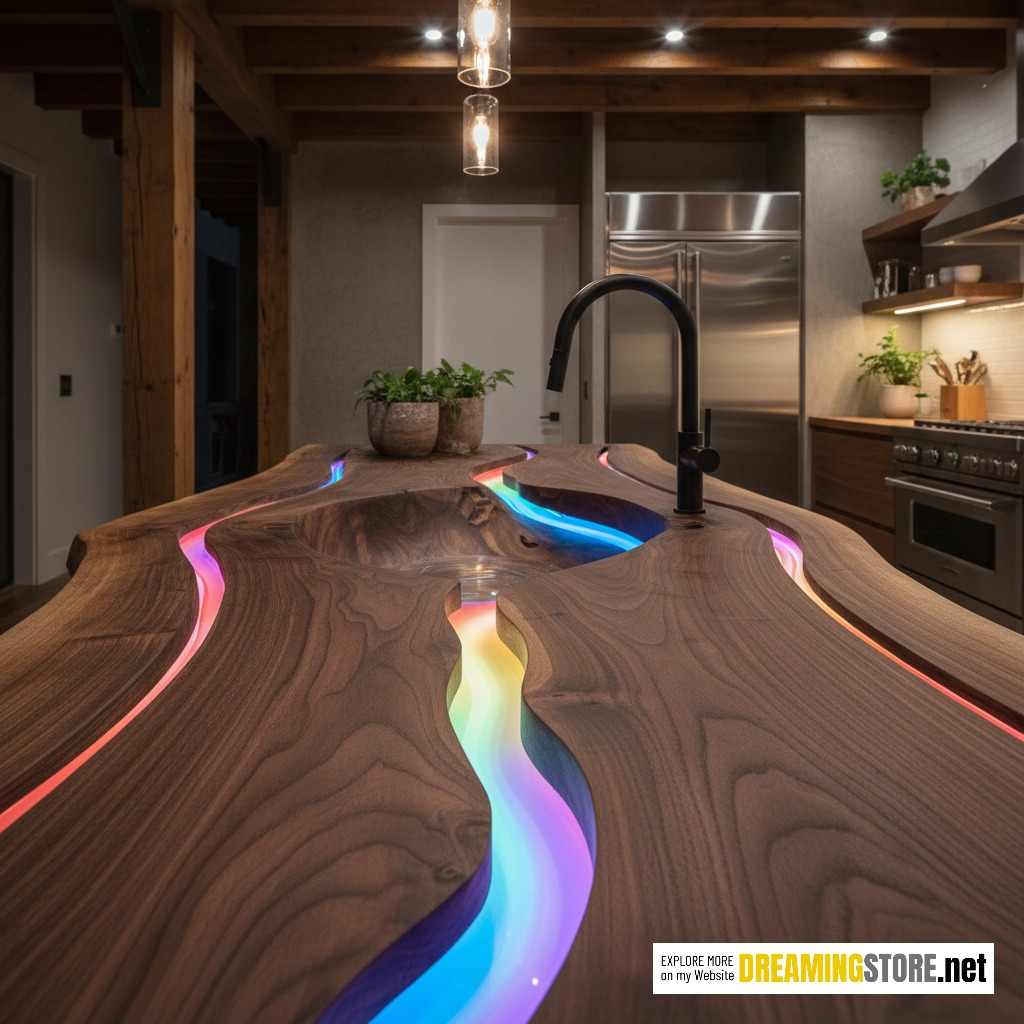In modern interior design, innovation and craftsmanship are merging in the most dazzling ways imaginable. One of the most captivating trends lighting up contemporary kitchens and bars is the illuminated wood countertop. By merging the natural warmth of wood with the high-tech allure of LED lighting, these countertops create a statement that’s both artistic and functional.
This guide explores everything you need to know — from design benefits and material considerations to potential drawbacks and maintenance needs — so you can decide whether an illuminating wood countertop is the right choice for your home.

What Is an Illuminated Wood Countertop?
An illuminated wood countertop integrates LED lighting—usually placed within resin inlays, live edges, or channels carved into the surface—to create a soft, radiant glow from within the wood. These lights can be single-color, color-changing, or even smart-enabled, allowing users to adjust brightness and hues with a mobile app or remote control.
Designers often combine natural hardwoods such as walnut, oak, or maple with clear or tinted epoxy resin. The LED strips are embedded discreetly within the epoxy lines, producing a glow that accentuates the natural grain of the wood. The result is a countertop that feels alive—flowing with light like molten rivers or veins of luminescence.
The Beauty Behind the Design
A major reason homeowners gravitate toward the illuminated wood countertop trend is its unmatched ability to blend nature with technology. Each design is completely unique, driven by the organic curves and patterns of the wood. When paired with LED illumination, these natural details transform into mesmerizing visual art pieces.
The wood’s live edge—its raw, uncut border—is often highlighted by light, giving a sculptural and earthy appeal. In darker kitchens or evening settings, the illumination provides a warm and inviting atmosphere, perfect for entertaining or unwinding after a long day.

Designers also love the flexibility. LEDs can be placed along the grain, beneath resin rivers, or under raised edges. Whether glowing amber for a rustic tone or neon blue for a futuristic touch, the illuminating wood countertop adapts effortlessly to various interior themes — modern, industrial, rustic, or even coastal.
The Pros of Installing an Illuminated Wood Countertop
1. Unparalleled Aesthetic Appeal
The most obvious advantage is visual. An illuminated wood countertop is a work of art that immediately becomes the centerpiece of any space. It elevates your kitchen from functional to unforgettable. The interplay of glowing lines and natural wood patterns evokes emotions — calmness, inspiration, or even awe — depending on the color and design.
No two countertops are identical, ensuring a sense of individuality and craftsmanship that factory-made surfaces can never replicate.
2. Warm and Inviting Ambience
Unlike cold stone or steel surfaces, wood naturally emits warmth — both visually and physically. When you add LED illumination, the glow enhances that coziness. Whether you choose amber tones for rustic charm or cool blues for a modern vibe, the illuminating wood countertop transforms everyday cooking or dining into a sensory experience.
The gentle light also doubles as mood lighting, meaning you can skip harsh overheads during relaxed evenings or romantic dinners.
3. Customization and Personal Expression
Customization is one of the biggest selling points. You can choose the species of wood, the resin color, the LED hue, and the placement of the lights. Want a glowing river of light across your island? Or perhaps a circular illuminated sink feature like molten lava? Anything is possible with the right craftsman.
Some homeowners even sync the lighting with their smart home systems, allowing voice or app control over brightness and color. This adaptability makes the illuminated wood countertop ideal for those who love design that evolves with their mood or the season.
4. Functional Night Lighting
Beyond aesthetics, these countertops serve a practical function. The built-in illumination acts as soft ambient lighting for nighttime use — perfect for midnight snacks or early morning coffee runs without blinding yourself with bright overheads.
When installed in bars or entertainment areas, the lighting sets the tone for parties, gatherings, and events. It’s functional elegance at its finest.
5. Sustainability and Natural Appeal
For eco-conscious homeowners, wood remains a renewable, sustainable resource — especially when responsibly sourced. Combined with energy-efficient LEDs, the illuminating wood countertop aligns with environmentally friendly design principles. It offers the best of both worlds: modern luxury and ecological mindfulness.
6. Increased Property Value and Wow Factor
Unique home features always add resale value. A well-crafted illuminated wood countertop not only distinguishes your home but can also make a lasting impression on potential buyers. It communicates high-end taste and attention to detail, signaling a thoughtfully designed space rather than a generic remodel.
Even if you’re not selling soon, it enhances your everyday living experience by turning ordinary kitchen interactions into something extraordinary.

The Cons of Installing an Illuminated Wood Countertop
While it’s easy to be captivated by the glowing beauty of these countertops, it’s crucial to understand the practical and financial considerations before investing.
1. High Cost and Complex Installation
The craftsmanship required for an illuminated wood countertop makes it significantly more expensive than standard wood or stone surfaces. Each unit must be custom-designed, integrating wiring, LEDs, resin casting, and sometimes smart technology.
Depending on materials and size, the cost can range from $150 to $500 per square foot, with intricate designs costing even more. Additionally, professional installation is essential — combining carpentry, electrical, and epoxy work. DIY attempts can lead to poor finishes, uneven lighting, or even safety hazards.
2. Maintenance and Durability Concerns
Wood is beautiful but sensitive. It can be scratched, dented, or damaged by water and heat if not properly sealed. The addition of embedded lighting components adds another maintenance layer. Electrical connections, LED strips, or epoxy channels can deteriorate over time if exposed to moisture or extreme temperature shifts.
To maintain a pristine illuminated wood countertop, you’ll need to:
-
Regularly reseal the wood surface.
-
Keep liquids away from electrical components.
-
Use gentle cleaning agents.
-
Avoid placing hot pots directly on the wood.
Though durable when maintained, it’s not as carefree as quartz or granite.
3. Potential Electrical Issues
Because LEDs and wiring are integrated within or beneath the wood, any electrical failure can be challenging to repair. Unlike changing a light bulb, fixing embedded lighting might require partial disassembly of the countertop or professional electrical intervention.
To minimize risks, always ensure the system is installed by a licensed electrician and use waterproof, low-voltage components.
4. Limited Heat Resistance
While epoxy resins and LED housings can withstand mild warmth, prolonged heat exposure can lead to damage or discoloration. The illuminated wood countertop should not be used as a direct cooking or baking surface. Always use trivets or heat pads to protect it from cookware.
5. Not Ideal for Every Home Style
As stunning as it is, an illuminating wood countertop doesn’t fit every design theme. Minimalist or ultra-traditional interiors may clash with its bold lighting effects. It thrives in modern, artistic, or nature-inspired homes, but might feel out of place in more conservative aesthetics.
For balance, some designers integrate subtle, low-intensity lighting or selective glow zones to achieve harmony in classic interiors.
Materials & Construction Insights
An illuminated wood countertop typically features:
-
Solid Wood Base: Common species include walnut, maple, oak, and acacia for strength and rich grain.
-
Epoxy Resin Channels: These transparent or tinted channels encase LED strips and enhance visual depth.
-
LED Light Strips: Flexible, low-voltage, and energy-efficient LEDs that emit varying colors and brightness levels.
-
Power Supply & Controls: Hidden adapters, remote dimmers, or smart systems for user convenience.

The surface can be matte or glossy, depending on preference. For rustic appeal, many homeowners keep the live edge natural, accentuating the wood’s original contour. In high-end builds, CNC machining is used to carve perfectly symmetrical channels for light diffusion.
Installation Considerations
Installing an illuminating wood countertop requires collaboration between a carpenter, resin specialist, and electrician. Here’s a simplified overview:
-
Design Planning: Choose your wood species, grain direction, and LED color scheme. Plan wiring routes and lighting zones early.
-
Wood Preparation: The slab is cut, dried, and treated to prevent future warping.
-
Channel Cutting: Grooves or resin paths are carved to embed LEDs.
-
LED Installation: Lights are fixed securely, wired through hidden conduits.
-
Epoxy Pouring: Transparent or colored resin encapsulates the lights.
-
Finishing & Sealing: Sanding, polishing, and sealing ensure a flawless surface.
It’s a meticulous process — more of a functional art project than a standard installation — which explains its cost and prestige.
Price Range Overview
The cost of an illuminating wood countertop depends heavily on complexity:
| Feature Type | Approximate Cost per Sq. Ft. | Description |
|---|---|---|
| Basic LED Edge Lighting | $150 – $250 | Simple LED strip along the countertop edge |
| Embedded Epoxy River Design | $250 – $400 | Custom resin channel with embedded lighting |
| Smart RGB or App-Controlled Setup | $350 – $500+ | Full-color LED control and advanced customization |
Additional costs include professional installation, sealing, and wiring integration, which can add $1,000–$3,000 to the total project.
Links to purchase similar products: Click here
Eco-Friendly Perspective
LED lighting consumes minimal power and produces little heat, making it a sustainable complement to reclaimed or responsibly sourced timber. The combination embodies eco-luxury — appealing to homeowners who want beauty without environmental compromise.
Choosing a local craftsman who sources regional hardwoods further reduces carbon footprint and supports sustainable woodworking traditions.
An illuminated wood countertop is more than a design trend — it’s a statement of creativity, craftsmanship, and modern innovation. It brings together the raw soul of timber and the sleek magic of light, creating an ambiance unlike any other.
Though it comes with higher costs and some maintenance needs, the results are breathtaking. Whether glowing in a soft amber river or pulsating in a spectrum of colors, this design will make your kitchen feel alive, warm, and extraordinary.
If your goal is to own a kitchen that not only functions beautifully but feels inspiring, then this luminous masterpiece may be your perfect match.



